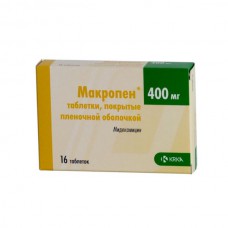Expiration date: 06/2025
Composition and form of issue:
Tablets, film-coated, 1 tablet contains:
midecamycin 421 mg*
(corresponds to 400 mg of midecamycin with an activity of 1000 µg / mg)
auxiliary substances: potassium, polacrilin magnesium stearate talc MCC
shell: titanium dioxide talc macrogol methacrylic acid copolymer
in blistere 8 PCs the paper cartons 2 blister.
Granules for suspension preparation for intake, 1 g contains:
midecamycin acetate 200 mg
(corresponds to 175 mg midecamycin acetate in 5 ml suspension)
excipients: methyl parahydroxybenzoate parahydroxybenzoate citric acid sodium hydrogen phosphate anhydrous flavor banana dye "sunset" yellow FCF (E110) polymer silicone antifoam sodium saccharin mannitol
* calculated by the content of midecamycin 950 µg / mg
in bottles of dark glass with an aluminum lid with the control of the first opening of 20 g, complete with a dosing spoon in a pack of cardboard 1 set.
Description of dosage form:
Tablets: round, slightly biconvex, with bevelled edges and a notch on one side, coated in white.
Kind of on a break-white mass with rough surface.
Granules for the preparation of suspensions for oral administration: small granules of orange color, with a slight aroma of banana, without visible impurities.
Aqueous suspension prepared in 100 ml of water, orange color, with a slight aroma of banana.
Pharmacokinetics:
After ingestion, the drug is rapidly and completely absorbed from the gastrointestinal tract.
Cmax midecamycin and midecamycin acetate in serum — 0, 5-2, 5 mg/l 1, 31-3, 3 g/l, respectively are reached 1-2 h after ingestion.
High concentrations of midecamycin and midecamycin acetate are created in the internal organs (especially in the tissues of the lungs, parotid and submandibular glands) and the skin.
IPC maintained for a period of 6 h T1/2 approximately 1 h. protein Binding is 47% midecamycine and 3-29% of metabolites.
The drug is metabolized in the liver to form 2 active metabolites with antimicrobial activity. It is excreted with bile and to a lesser extent (about 5%) kidneys.
Plasma concentrations, AUC and T1/2 increased significantly in liver cirrhosis.
Description of the pharmacological action:
Macropen — a macrolide antibiotic which inhibits protein synthesis of bacterial cells, has a bacteriostatic effect in low doses, in high — bactericidal. Reversibly binds to 50S ribosomal subunit of the membrane of the bacteria. It is effective against intracellular microorganisms: Mycoplasma spp., Chlamydia spp., Legionella spp., Ureaplasma urealyticum of gram-positive bacteria: Streptococcus spp., Staphylococcus spp., Coronebacterium diphtheriae, Listeria monocytogenes, Clostridium spp. some gram-negative bacteria: Neisseria spp., Moraxella catarrhalis, Bordetella pertussis, Helicobacter spp., Campylobacter spp., Bacteroides spp.
Indications:
Infectious and inflammatory diseases caused by microorganisms sensitive to the drug:
- respiratory tract infections, including those caused by atypical pathogens (Mycoplasma, Legionella, chlamydia and Ureaplasma urealyticum) - tonsillopharyngitis, acute otitis media, sinusitis, exacerbation of chronic bronchitis, community-acquired pneumonia
- infections of the genitourinary tract caused by atypical pathogens-Mycoplasma, Legionella, chlamydia and Ureaplasma urealyticum
- infections of the skin and subcutaneous tissue
- enteritis caused by bacteria of the genus Campylobacter
- diphtheria and whooping cough (treatment and prevention).
Contraindications:
- hypersensitivity to midecamycin / midecamycin acetate and any other components of the drug
- severe hepatic insufficiency
- children under 3 years (for tablets).
With caution:
- pregnancy
- lactation
- the presence of an allergic reaction to acetylsalicylic acid.
Application for pregnancy and breastfeeding:
The use of the drug during pregnancy is shown only in cases where the potential benefit to the mother exceeds the risk to the fetus.
Nursing mothers should stop breast-feeding during treatment with Macropen, because the drug is excreted in breast milk.
Side effect:
From the digestive tract: decreased appetite, stomatitis, nausea, vomiting, diarrhea, feeling of heaviness in epigastrium, increased activity of hepatic transaminases, hyperbilirubinemia, jaundice.
In rare cases, severe and prolonged diarrhea may occur, which may indicate the development of pseudomembranous colitis.
Allergic reactions: skin rash, urticaria, itching, zozinofiliya, bronchospasm.
Other: weakness.
Drug interaction:
In concomitant administration of ergot alkaloids or carbamazepine with Macropenis reduced their metabolism in the liver and increased serum concentration. Therefore the simultaneous administration of these drugs should be used with caution.
Does not affect the pharmacokinetic parameters of theophylline.
With the simultaneous use of Macropene with cyclosporine or anticoagulants (warfarin), the excretion of the latter slows down.
Method of application and doses:
Inside, before meals.
Adults and children weighing >30 kg: 1 table. (400 mg) 3 times a day. The maximum daily dose for adults is 1600 mg.
Children with body weight <30 kg: daily dose of 20-40 mg/kg divided into 3 doses, or 50 mg/kg in 2 admission.
In severe infections: daily dose-50 mg / kg, divided into 3 admission.
Scheme appointments Makropena in the form of suspension for children (daily dose — 50 mg/kg under 2-fold admission standards) presented in spreadsheet.
| Body weight (age) | Suspension (175 mg / 5 ml), 2 times a day |
| up to 5 kg (approximately 2 months) | 3, 75 ml (131, 25 mg) |
| up to 10 kg (approximately 1-2 years) | 7, 5 ml (262, 5 mg) |
| up to 15 kg (approximately 4 years) | 10 ml (350 mg) |
| up to 20 kg (approximately 6 years) | 15 ml (525 mg) |
| up to 30 kg (approximately 10 years) | 22, 5 ml (787, 5 mg) |
Duration of treatment - from 7 to 14 days, in the treatment of chlamydia infections — 14 days.
For the purpose of prevention of diphtheria is recommended at a dose of 50 mg/kg/day divided in 2 doses for 7 days. Control bacteriological examination after the end of therapy is recommended.
In order to prevent whooping cough is recommended at a dose of 50 mg/kg/day for 7-14 days in the first 14 days of contact.
Preparation of the suspension
To the contents of the bottle add 100 ml of water (boiled or distilled) and shake well.
Before use, shake!
Overdose:
There are no reported cases of serious overdose, caused by Macropool.
Symptoms (possible): nausea, vomiting.
Treatment: symptomatic.
Special instruction:
During long-term therapy, the activity of liver enzymes should be monitored, especially in patients with impaired liver function.
As with all other antimicrobials, prolonged treatment can lead to excessive growth of resistant bacteria. Prolonged diarrhea may indicate the development of pseudomembranous colitis.
Mannitol, contained in Macropene (granules for the preparation of suspensions for oral administration), may be the cause of diarrhea.



